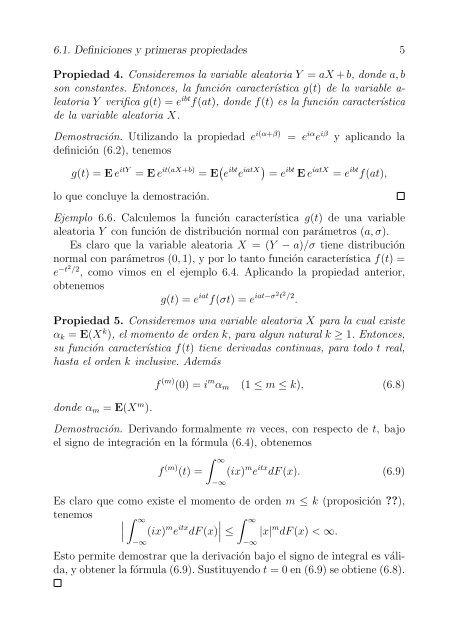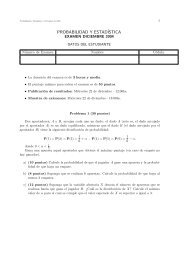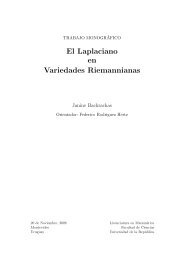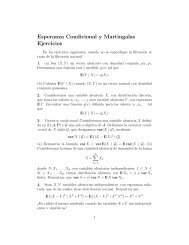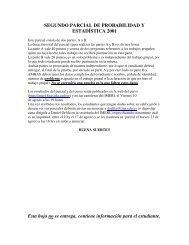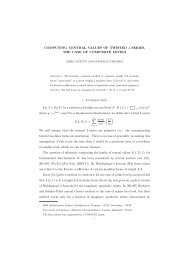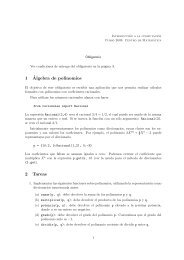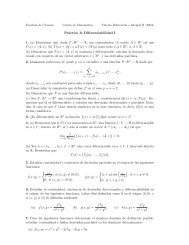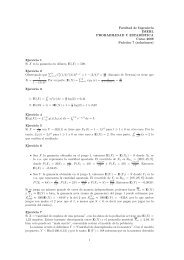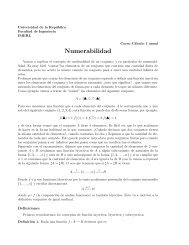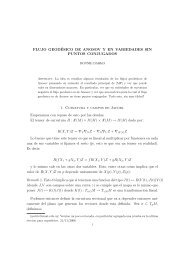CapÃtulos 6 y 7 de Petrov. V.V, Mordecki, E. TeorÃa de la ...
CapÃtulos 6 y 7 de Petrov. V.V, Mordecki, E. TeorÃa de la ...
CapÃtulos 6 y 7 de Petrov. V.V, Mordecki, E. TeorÃa de la ...
Create successful ePaper yourself
Turn your PDF publications into a flip-book with our unique Google optimized e-Paper software.
6.1. Definiciones y primeras propieda<strong>de</strong>s 5Propiedad 4. Consi<strong>de</strong>remos <strong>la</strong> variable aleatoria Y = aX + b, don<strong>de</strong> a, bson constantes. Entonces, <strong>la</strong> función característica g(t) <strong>de</strong> <strong>la</strong> variable a-leatoria Y verifica g(t) = e ibt f(at), don<strong>de</strong> f(t) es <strong>la</strong> función característica<strong>de</strong> <strong>la</strong> variable aleatoria X.Demostración. Utilizando <strong>la</strong> propiedad e i(α+β) = e iα e iβ y aplicando <strong>la</strong><strong>de</strong>finición (6.2), tenemosg(t) = E e itY = E e it(aX+b) = E ( e ibt e iatX) = e ibt E e iatX = e ibt f(at),lo que concluye <strong>la</strong> <strong>de</strong>mostración.Ejemplo 6.6. Calculemos <strong>la</strong> función característica g(t) <strong>de</strong> una variablealeatoria Y con función <strong>de</strong> distribución normal con parámetros (a, σ).Es c<strong>la</strong>ro que <strong>la</strong> variable aleatoria X = (Y − a)/σ tiene distribuciónnormal con parámetros (0, 1), y por lo tanto función característica f(t) =e −t2 /2 , como vimos en el ejemplo 6.4. Aplicando <strong>la</strong> propiedad anterior,obtenemosg(t) = e iat f(σt) = e iat−σ2 t 2 /2 .Propiedad 5. Consi<strong>de</strong>remos una variable aleatoria X para <strong>la</strong> cual existeα k = E(X k ), el momento <strong>de</strong> or<strong>de</strong>n k, para algun natural k ≥ 1. Entonces,su función característica f(t) tiene <strong>de</strong>rivadas continuas, para todo t real,hasta el or<strong>de</strong>n k inclusive. A<strong>de</strong>másdon<strong>de</strong> α m = E(X m ).f (m) (0) = i m α m (1 ≤ m ≤ k), (6.8)Demostración. Derivando formalmente m veces, con respecto <strong>de</strong> t, bajoel signo <strong>de</strong> integración en <strong>la</strong> fórmu<strong>la</strong> (6.4), obtenemosf (m) (t) =∫ ∞−∞(ix) m e itx dF (x). (6.9)Es c<strong>la</strong>ro que como existe el momento <strong>de</strong> or<strong>de</strong>n m ≤ k (proposición ??),tenemos ∣ ∫ ∞∫ ∞∣∣(ix) m e itx dF (x) ∣ ≤ |x| m dF (x) < ∞.−∞Esto permite <strong>de</strong>mostrar que <strong>la</strong> <strong>de</strong>rivación bajo el signo <strong>de</strong> integral es válida,y obtener <strong>la</strong> fórmu<strong>la</strong> (6.9). Sustituyendo t = 0 en (6.9) se obtiene (6.8).−∞


